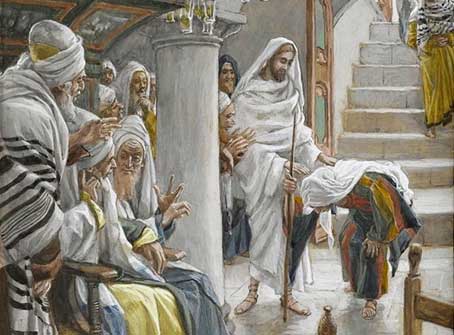LESSON 13: Healing Crippled Woman
Lesson 13: Healing Crippled Woman
A long time ago, Jesus was teaching in a synagogue. A synagogue is like a church where people gather to pray and learn about God. It was the Sabbath day, a holy day of rest when people did not work.
While Jesus was teaching, He saw a woman who was very sick. She had been bent over for 18 years and could not stand up straight (Luke 13:10-17). Her back was curved, and it was very painful. The woman didn’t ask Jesus for help, but Jesus saw her and had kindness and love in his heart.
Fortunately, there is One in the crowded synagogue who does not look down upon this woman. Jesus sees her among the people and calls her to him. Bravely, she pushes past those who stand straight and tall, and with her imperfect body, comes to Christ. He then reaches out his hand to touch her. Jewish men did not customarily touch women whom they were not related to. They feared it could make them ritually unclean. Nevertheless, he lays his hand upon her and says, “Woman, you are set loosed from your infirmity” (Luke 13:12). The original Greek word here for “loosed” means to be released or liberated. Immediately, for the first time in almost two decades, she is able to rise and stand straight. She was so happy and thankful that she began to praise God.
Not everyone was happy that Jesus healed the woman. The Jewish leaders were not impressed. They immediately began to criticize Jesus for performing this miracle on the Sabbath. While Jesus had not broken the law, he had broken down what was known as the “oral law.” For years, the leadership had built a barrier or a fence, around the laws of God with a series of cultural traditions or rules in an attempt to prevent one from breaking any commandments. As these barriers became more and more restrictive, it distanced the people from the true purpose of the law, hiding it from their view. Jesus exposes the hypocrisy of these supposed laws by pointing out that the true purpose of the Sabbath has been lost. He teaches that this holy day is set aside for the Lord’s work. It is a day to commemorate the creation, for remembering the deliverance from slavery in Egypt, and to praise God.
The woman has come to be refreshed spiritually, as have all the others. What better day to be healed than on the Sabbath day! How fitting that once made whole, she glorifies the Lord, for it is especially on this day we are to pay our devotions unto the highest. Jesus declares, “You hypocrites! Doesn’t each of you on the Sabbath untie your ox or donkey from the stall and lead it out to give it water?” If even the Jews can give water to their animals on the Sabbath, when better for this woman to drink of the living water?
Everyone who was against Jesus felt embarrassed. But all the people watching were very happy and amazed at what Jesus had done.
What can we learn from this lesson?
The story of Jesus healing the crippled woman teaches us a powerful lesson about freedom from bondage. Just as the woman’s deformed back was healed after long suffering, so too can we be lifted up and freed from our own captivity by the healing touch of our loving Savior.
In the challenging world we live in today, we can feel like we are in bondage. Crippled with feelings of unworthiness, grief, depression, and anxiety, we might not see our own self-worth or feel we can lift ourselves up. We might compare our bodies given to us by God to what the world tells us perfection should look like. It can be easy to just focus on the ground below us failing to see the blue majestic skies above.
Questions:
- Where was Jesus when he healed the crippled woman, and what day of the week was it?
- How long had the woman been crippled before Jesus healed her?
- What did Jesus say to the woman before healing her?
- How did the synagogue leader react to the healing, and why?
- What was the crowd’s reaction after Jesus defended his actions?

